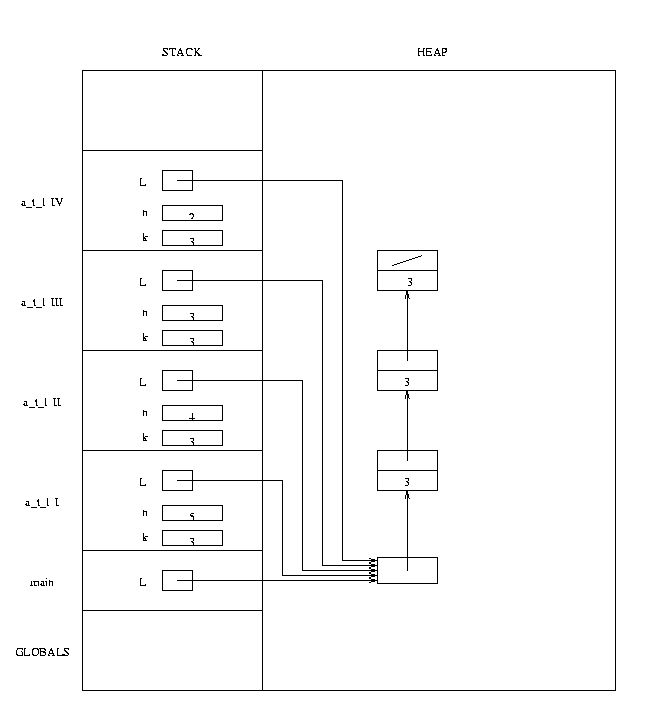Spring 2001, CSE 428: Solution of Final (4 May 2001)
Question 1
-
- 25 * 3 no
- 5 ^ 2 * 3 yes
- (5 ^ 2) * 3 no
- 5 * 2 * 3 yes
- There are two kinds of ambiguity:
- Associativity of ^
- Precedence between * and ^
An example of the first is:
Exp Exp
/|\ /|\
/ | \ / | \
Exp ^ Exp Exp ^ Exp
/|\ | | /|\
/ | \ | | / | \
Exp ^ Exp Num Num Exp ^ Exp
| | | | | |
| | | | | |
Num Num 4 2 Num Num
| | | |
| | | |
2 3 3 4
An example of the second is:
Exp Exp
/|\ /|\
/ | \ / | \
Exp ^ Exp Num * Exp
/|\ | | /|\
/ | \ | | / | \
Num * Exp Num 2 Exp ^ Exp
| | | | |
| | | | |
2 Num 4 Num Num
| | |
| | |
3 3 4
- An equivalent non-ambiguous grammar where ^ has precedence over * is the following:
Exp ::= Exp * A | B
A ::= C ^ A | Num
B ::= C ^ B | C
C ::= Num | (Exp)
Num ::= 0 | 1 | 2 | 3 | 4 | 5 | 6 | 7 | 8 | 9
An equivalent non-ambiguous grammar where * has precedence over ^ is the following:
Exp ::= A ^ Exp | A
A ::= Num * A | Num | (Exp)
Num ::= 0 | 1 | 2 | 3 | 4 | 5 | 6 | 7 | 8 | 9
Question 2 (Memory management)

Question 3 (Concurrency in Java)
class Account {
private int balance;
public Buffer(int initialDeposit) { balance = initialDeposit; }
public synchronized int getBalance() {
return balance;
}
public synchronized void deposit(int amount) {
if (amount < 0)
error(1) % the amount to deposit should be non negative
else {
balance = balance + amount;
notifyAll();
}
}
public synchronized void withdraw(int amount) { //we omit the treatment of interruptedExeption
if (amount < 0)
error(1) % the amount to withdrow should be non negative
else {
while (balance < amount) wait();
balance = balance - amount;
}
}
}
class AccountHolder extends Thread {
Account a;
...
public void run() {
...
a.deposit(x);
...
a.withdraw(y); // no need to test that the balance is greater than or equal to the amount to withdraw
...
}
}
Note that the wait() command is used in a method
of Account, not in run(). It would make no sense
to use wait() in run() (and it would also
give a compilation error).
Question 4 (ML)
fun max(x,y) = if x > y then x else y;
fun heights(leaf x) = leaf 1
| heights(node(t1,x,t2)) = let val (h1,u1) = heights t1
and val (h2,t2) = heights t2
in node(u1, max(h1,h2)+1, u2)
end;
Another alternative solution, perhaps more elegant, is the following:
fun root (leaf x) = x
| root (node(t1,x,t2)) = x;
fun heights(leaf x) = leaf 1
| heights(node(t1,x,t2)) = let val u1 = heights t1
and val u2 = heights t2
in node(u1, max(root u1, root u2) + 1, u2)
end;
Question 5 (Prolog)
divisor_and_rest(M,N,X,Y) :- nat(X,N), nat(Y,N), N is M * X + Y.
nat(M,M) :- M >= 0.
nat(X,M) :- M > 0, N is M - 1, nat(X,N).
Question 6 (Prolog)
conc([],[]).
conc([X|L],K) :- conc(L,M), append(X,M,K).
